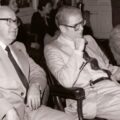Apr 1, 2011
The More We Perceive…The More We Receive
My mentor Saul Feinberg once said those words in my presence. I nodded in assent, to which he added, “Feel free to use that.” I have and I do. Saul’s distillation of what happens when we give our undivided attention to anything has many ramifications. I suppose a case might be made that to remain in a constant state of attentiveness could result in sensory overload! However, the selective use of this behavior can definitely result in a life very rich in pleasurable, meaningful and even important observations.
This adoption of a perceptive state of mind should by no means be limited to sound. I recall that on a visit to Africa, our tracker, who’d been sitting on a special seat on the front bumper, abruptly relocated himself to a seat safely next to our driver. He then turned his head toward us and whispered, “Large cat nearby.” His perceptive eyes, ears and probably sense of smell had obviously detected something we had not!
Think about how important our visual perception of tiny eye movements, eyebrow twitches and lip quivers are as they are projected toward us by our spouses, parents, children, siblings and close friends. If we do not perceive these subtle signals.
Hearing is, of course, that miraculous sense by which sound waves enter the ear canal, set tiny hairs, bones and liquid in motion and, after being transmitted electronically over nerve tissue, are then “translated” by our brain into things like words and music. Gives one goosebumps just to think about it!
Listening, however, is paying attention to those sounds being heard by our physical apparatus – an apparatus which percussionist Evelyn Glennie has beautifully shown us extends way beyond our ears! This state of auditory mindfulness probably has a thousand of degrees of acuity that can be dialed up and down by human beings at will – all the way from ‘barely noticing anything’ to ‘observing every detail.’
We are all capable of applying that full range of mindfulness to musical sounds physically produced in real time outside us. And, like composers, we can also apply this mindful-state to the details of music “heard” only virtually in our heads. It really makes no difference whether we are dealing with virtual-imagined music or actual physical sound waves. The listening all takes place “between our ears” in the brain and simultaneously “amplified” or felt throughout our central nervous and endocrine systems.
One thing is certain. The more musical detail we perceive. . .the richer, the more powerful will be the aesthetic experience we receive from listening!









